Some of the simplest picture books are concept books. Books about sound, color, shapes, seasons… ways that we categorize the world that will be new to a toddler. Concept books might often seem like just random lists, but the good ones have an underlying structure that takes more planning than it seems.
A lot has to do with the order in which information is presented. It can be an order is natural to the concept itself such as the passage of seasons or the sequence of the colors in a rainbow, but often the author has to work to impose order. A lot of the pleasure of a concept book is to see how an author and illustrator do this.
A great example is the picture book Buzz by Janet Wong, illustrated by my blog-mate Margaret Chodos-Irving. It’s a book I’ve used in my writing classes long before I knew Janet or Margaret, because what could be a simpler idea than different things that buzz? But it’s far from a random collection of buzzes.
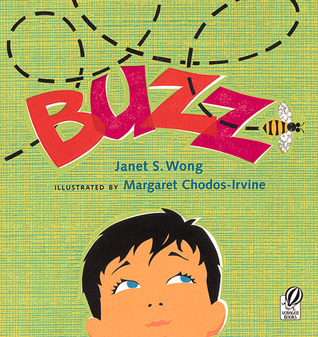
In this case, author and illustrator explore the different buzzing sounds a boy hears as his household wakes up.
It starts with the single word: “Buzz.” as a boy sleepily looks out his window. Then a page turn.

“Outside my window a bee eats breakfast in a big red flower.”
It then moves through the boy’s morning. The buzz of the alarm clock in his parent’s room. Dad shaving. The sound of the gardener mowing across the street. There’s one “buzz” sound per page. And they are relatively peaceful, everyday buzzes. The language is mostly simple declarative sentences.
Then comes breakfast and something interesting happens. The activity level picks up and the language gets more complex:
Mommy grinds coffee Buzzzzzzzzzzz while I fly my airplane Buzzzzzzzzz over the oatmeal Buzzzzzzz and past the apple juice Buzzzzzzz—OH NO!
All this activity happens on one page quickening the pace of the story.
On the next page, there are no buzz sounds—just mild chaos. Airplane lands in juice, cup spills, mom runs to catch cup, toast pops up, clothes are tumbling in dryer and then the BUZZZZ of the dryer gets buzzing back into the story, but now with more urgency. Mom is on the move getting ready to go to work. Buzz goes her hairdryer. Grandma buzzes the doorbell to come baby-sit. Boy kisses Mom goodbye…
“so she can fly BUZZ outside”
(page turn and we see Mom hurrying off to work)
“like a busy bee.”

There’s plenty of structure here. The sequence of the buzzes matches the natural order of a morning’s activities. The pace and urgency of the story gradually escalate into mild chaos in the kitchen and Mom suddenly needs to rush to get out the door—this is the top of the story arc. Then the pace slows somewhat—not as leisurely as the beginning, but down off the peak and gradually we come in for a landing, with the closing image of the bee that perfectly rounds out the story at the same place we came in.

A consistent pattern or rhyming scheme is another way to add structure to a simple book. I wrote a concept book Tickly Prickly, illustrated by Shari Halpern (now out of print) about how things feel to the touch. It begins with:
Did you ever have a ladybug crawl across your finger?
How did it feel?
Tickly, prickly. Fly away quickly.
Every stanza that follows asks a question about how it feels to touch a familiar animal and answers that question within a consistent rhyming scheme.
Did you ever have a fish wriggle in your hands?
How did it feel?
Slippery, slickery. Turny and twistery.
Ending with:
Did you ever have a puppy cuddle in your arms?
How did it feel?
Velvety snug. A hugful of love.
Like Wong, I had to find an narrow focus for my book. I picked the feel of animals—not the feel of a bedtime blanket or a snowball. And I picked familiar animals—bunnies, chicks, a cat’s paw—not a hippo hide or the beak of a stork. But I could have gone in those other directions. The main thing is to have a direction, a reason for the choices.
 (By the way, the symbols at the top of this illustration are from an iTunes app that’s available for this book.)
(By the way, the symbols at the top of this illustration are from an iTunes app that’s available for this book.)
There’s almost no build to the march of animals in Tickly Prickly, but the middle does feature perhaps the more interesting animals that might be in an average child’s world—a horse, a lake fish, a toad. And, it very deliberately ends with the coziest emotion, snuggling with a dog.
Ending with the coziest emotions is my favorite go-to for most concept books, but there are other ways to make sure you end in a satisfying place, including the ending of a day (a built-in cozy moment with a goodnight tuck-in or hug), the reward or result of that activity (the baked cake) or going full circle.
Taro Gomi’s, Spring Is Here is a perfect example of the circular ending.

Spring Is Here is so deceptively simple. The prose couldn’t be more straightforward. It begins:
Spring is here.
The snow melts.
The earth is fresh.
The grass sprouts.
Each line is a new, two-page spread.

But not only is there a lovely trick he plays with the illustrations (you’re going to have to get this one to see what he does. It’s worth it.) he, too, creates a build as we move from flowers blooming and grass growing to a little drama in the middle:
The wind blows.
The storms rage.
And then back down into the quiet harvest, falling snow and a hushed world. Before returning to:

For more concept books to check out, I like this list compiled by the Contra Costa County Library (plus it’s fun to say all those C-words.)
http://guides.ccclib.org/c.php?g=43934&p=1046403
The Seattle Public Library also has this list:
https://seattle.bibliocommons.com/list/show/73413760__seattle_kids_librarians/85218609_seattle_picks_-_concept_books
And here’s this from Goodreads:
https://www.goodreads.com/shelf/show/concept-books









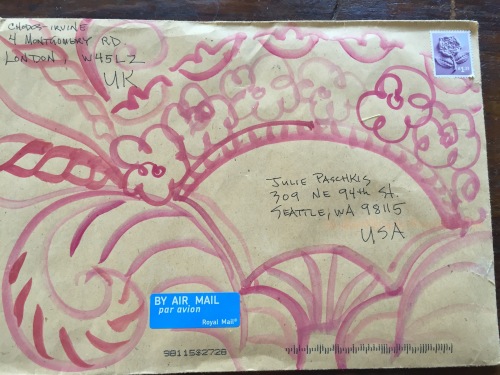









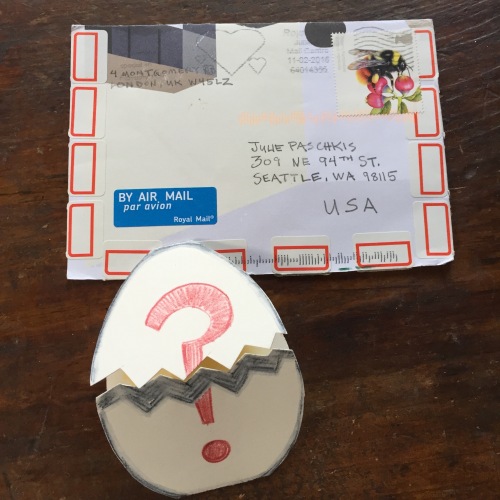

















 Julie sent me this after I told her about a missing teapot from my parents’ home.
Julie sent me this after I told her about a missing teapot from my parents’ home.

 Arrows were a common theme for me. Julie responded in kind.
Arrows were a common theme for me. Julie responded in kind. Julie and I exchanged squiggles at one point, and then colored them in and sent them back.
Julie and I exchanged squiggles at one point, and then colored them in and sent them back. Some of the letters were 3-D.
Some of the letters were 3-D. Others had movable parts!
Others had movable parts!

 Rose colored glasses to induce optimism.
Rose colored glasses to induce optimism.
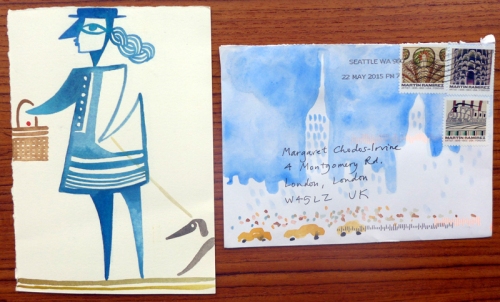

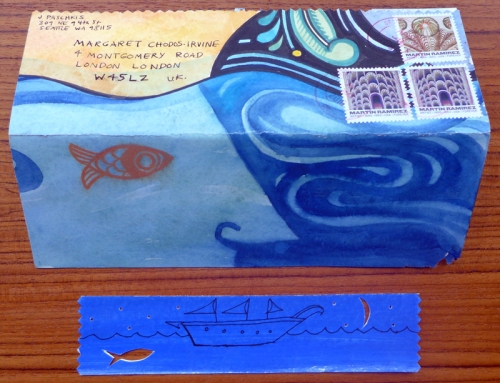


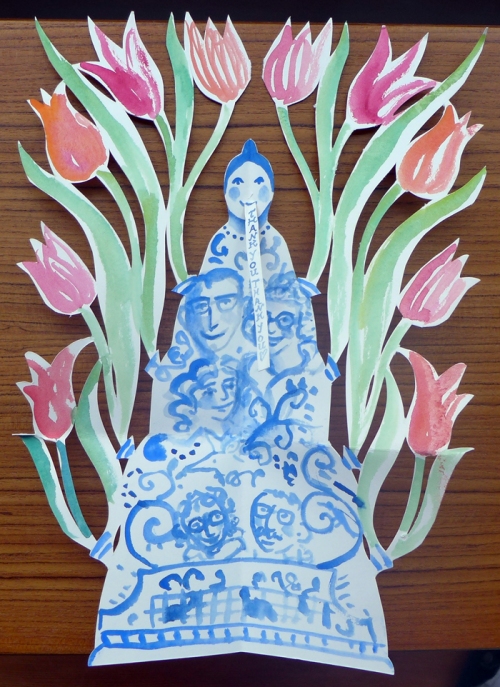 This was a Thank You note from Julie after she and her husband Joe visited us and we took a trip to Amsterdam.
This was a Thank You note from Julie after she and her husband Joe visited us and we took a trip to Amsterdam. Julie sent me this after I met her in New York for a visit.
Julie sent me this after I met her in New York for a visit. A letter for a new year.
A letter for a new year. And this was one of the last letters Julie sent me. It is me, returning to Seattle (the handle on the suitcase goes up and down and the flaps open).
And this was one of the last letters Julie sent me. It is me, returning to Seattle (the handle on the suitcase goes up and down and the flaps open).







